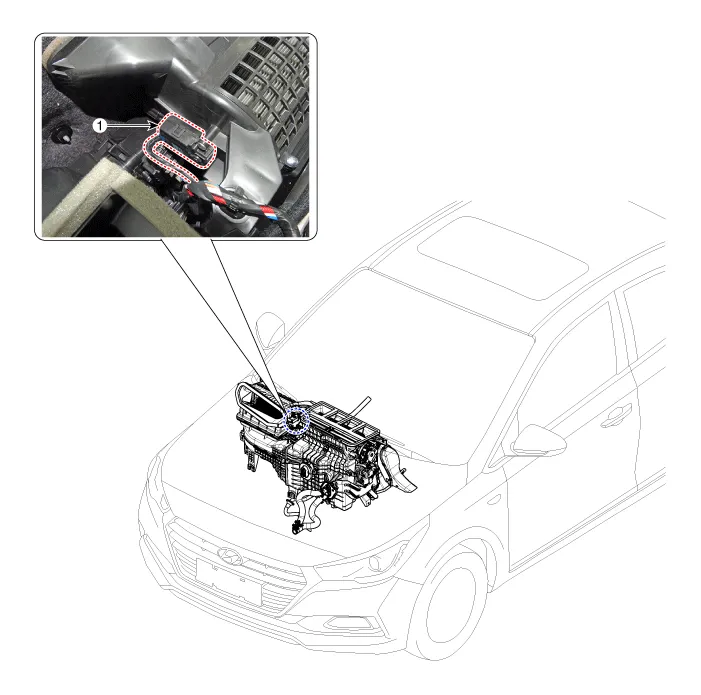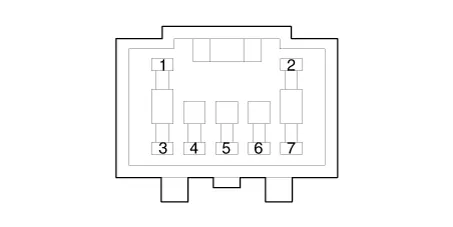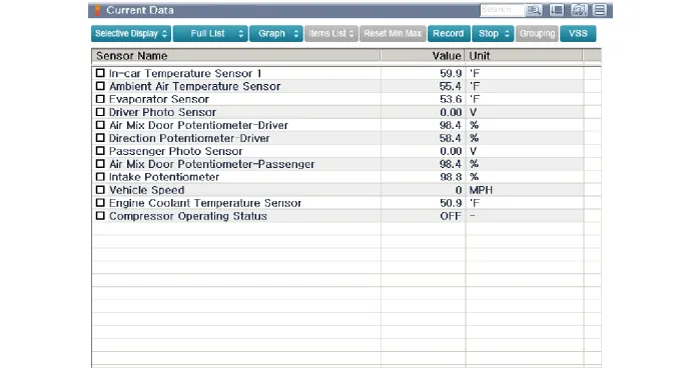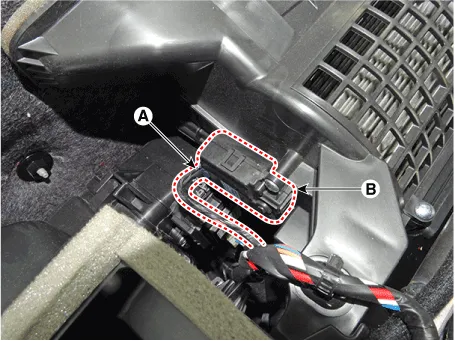Hyundai Accent (HC): Blower / Intake Actuator

1. Intake actuator
| Door position | Voltage (V) | Error detecting |
| Fresh | 0.3 ± 0.15 | Low voltage : 0.1V or less |
| Recycle | 4.7 ± 0.15 | High voltage : 4.9V or more |
1.Turn the ignition switch OFF.
2.Disconnect the intake actuator connector.
3.Verify that the intake actuator operates to the fresh position when connecting 12V to terminal 6 and grounding terminal 5.Verify that the intake actuator operates to the recirculation position when connected in reverse.

| Pin NO | Function |
| 1 | - |
| 2 | - |
| 3 | Fresh air |
| 4 | Sensor (+5V) |
| 5 | Feedback signal |
| 6 | Sensor ground |
| 7 | Recirculated air |
4.Connect the intake actuator connector.
5.Turn the ignition switch ON.
6.Check the voltage between terminal 6 and 5.
7.If the measured voltage is not within specification, check the operation by replacing the existing intake actuator with a new genuine part. After that, determine whether replacement of the temperature control actuator is required or not.
1.The heating, ventilation and air conditioning can be quickly diagnosed failed parts with vehicle diagnostic system (GDS).※ The diagnostic system (GDS) provides the following information.(1) Self diagnosis : Checking the failure code (DTC) and display.(2) Current data : Checking the system input / output data state.(3) Actuation test : Checking the system operation condition.(4) Additional function : Other controlling such as he system option and zero point adjustment.
2.Select the 'Car model' and the system to be checked in order to check the vehicle with the tester.
3.Select the 'Current data' menu to search the current state of the input / output data.The input / output data for the sensors corresponding to the Intake Actuator can be checked.

4.To perform compulsory operation on Intake Actuator input factors, select "ACTUATION TEST".

1.Disconnect the negative (-) battery terminal.
2.Remove the main crash pad assembly.(Refer to Body - "Main Crash Pad Assembly")
3.Disconnect the connector (A) and then remove the intake actuator (B) after loosening the mounting screws.

4.To install, reverse the removal procedure.
Other information:
Hyundai Accent (HC) (2017 - 2022) Service Manual: Airbag Module Disposal
- Airbag Disposal When you scrap a vehicle equipped with an airbag, you must deploy it first.When you deploy an airbag, you need to have a skilled mechanic do the work. The used airbag should not be reinstalled in another vehicle for reuse. • Upon deployment, the explosion will create a loud noise, so you have to do it in a proper place not to disturb others.Hyundai Accent (HC) (2017 - 2022) Service Manual: Rear Seat Back Cover
- Component Location 1. Rear seat back cover [LH] 2. Rear seat back cover [RH] - Replacement Put on gloves to protect your hands. • Use a plastic panel removal tool to remove interior trim pieces without marring the surface. • Be careful not to bend or scratch the trim and panels. [LH] 1.
Categories
- Manuals Home
- Hyundai Accent Owners Manual
- Hyundai Accent Service Manual
- Questions & Answers
- Video Guides
- Useful Resources
- New on site
- Most important about car
- Privacy Policy
0.0063


